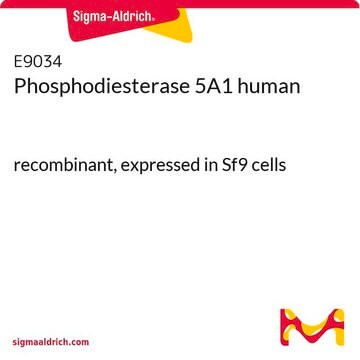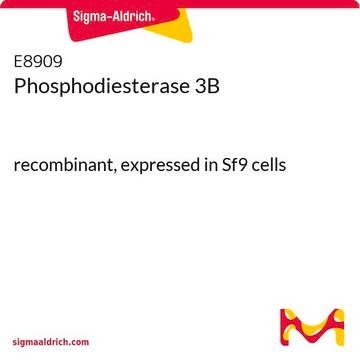P9041
Phosphodiesterase II from bovine spleen
lyophilized powder, ≥5.0 units/mg protein
Synonym(s):
3′-Exonuclease, Spleen exonuclease, Spleen phosphodiesterase
Sign Into View Organizational & Contract Pricing
All Photos(1)
About This Item
Recommended Products
form
lyophilized powder
specific activity
≥5.0 units/mg protein
mol wt
65 kDa
UniProt accession no.
foreign activity
5′-Nucleotidase ≤1% of base activity
storage temp.
−20°C
Gene Information
cow ... PDE2A(281971)
General description
Research area: Cell signaling. Phosphodiesterase (PDE) II belongs to the PDE superfamily and includes subtypes from one to 11. They exist as a dimer and comprise of N-terminal regulatory domain, C-terminal prenylated domain, and a Zn2+containing catalytic domain. The bovine spleen PDE2 corresponds to a molecular weight of 65 kDa. It requires divalent cations for its enzymatic activity and has an optimum pH of 7.5.
Application
Phosphodiesterase (PDE) is any enzyme that is used to break phosphodiester bonds. It is a membrane-bound glycoprotein that is used to catalyze the hydrolysis of various nucleotide polyphosphates. Phosphodiesterase II has been used in the enzymatic digestions of purified proteins such as the P8-dGMP complex. Bovine spleen phosphodiesterase has been used to digest N-cadherin. Phosphodiesterase II from bovine is suitable for sequential and end-group analysis of poly and oligonucleotides. It may be used in kinetic studieson substrate degradation of macro-molecules.
Phosphodiesterase II from bovine spleen has been used in the:
- excision of pyridyloxobutyl (POB) base adducts from DNA
- digestion of DNA prior to cycloadenosine enrichment
- hydrolysis of DNA from blue mussels gill tissue into deoxyribonucleoside 3′-monophosphates
The product has been used in the characterization of polynucleotide chain length, base composition, and identity of terminal nucleotide. The enzyme has also been used in excision of pyridyloxobutyl (POB) base adducts from DNA. Furthermore, it has been used along with micrococcal endonuclease to hydrolyze purified DNA to 3 -nucleoside monophosphates.
Biochem/physiol Actions
Phosphodiesterase (PDE) breaks phosphodiester bonds. 3-Isobutyl-methylxanthine (IBMX) is a potential PDE2 inhibitor.
The enzyme acts on poly(A), poly(U), and poly(I). Native DNA and poly(C) are quite resistant to the action of this enzyme.
Hydrolyzes RNA, RNA-Core, 3′-alkyl- and 3′-aryl-nucleoside phosphates, and polydeoxyribonucleotides with 3′-phosphate end groups to 3′-mononucleotides.
Polynucleotides having 5′-phosphomonoester end groups are not attacked.
Polynucleotides having 5′-phosphomonoester end groups are not attacked.
Unit Definition
One unit will produce acid soluble nucleotides equivalent to a ΔA260 of 16 in 30 min at pH 6.5 at 37 °C, in a 2.0 mL reaction mixture. Substrate: RNA-Core. Actual A260 is measured on the supernatant after precipitation of the unhydrolyzed RNA with uranyl acetate-perchloric acid reagent.
Analysis Note
Protein determined by biuret
Storage Class Code
10 - Combustible liquids
WGK
WGK 3
Flash Point(F)
Not applicable
Flash Point(C)
Not applicable
Personal Protective Equipment
dust mask type N95 (US), Eyeshields, Gloves
Certificates of Analysis (COA)
Search for Certificates of Analysis (COA) by entering the products Lot/Batch Number. Lot and Batch Numbers can be found on a product’s label following the words ‘Lot’ or ‘Batch’.
Already Own This Product?
Find documentation for the products that you have recently purchased in the Document Library.
Customers Also Viewed
Hong Feng et al.
Biochemistry, 44(34), 11486-11495 (2005-08-24)
Endonuclease V is an enzyme that initiates a conserved DNA repair pathway by making an endonucleolytic incision at the 3' side one nucleotide from a deaminated base lesion. Site-directed mutagenesis analysis was conducted at seven conserved motifs of the thermostable
J Balsamo et al.
The Journal of biological chemistry, 265(5), 2923-2928 (1990-02-15)
Calcium-dependent cell-cell adhesion among embryonic chick neural retina cells is mediated by N-cadherin, a 130,000-Da integral membrane protein. We have reported that the ability of chick neural retina cells to form calcium-dependent cell-cell adhesion is also correlated with the presence
Emily H Rubinson et al.
Nature, 468(7322), 406-411 (2010-10-12)
DNA glycosylases that remove alkylated and deaminated purine nucleobases are essential DNA repair enzymes that protect the genome, and at the same time confound cancer alkylation therapy, by excising cytotoxic N3-methyladenine bases formed by DNA-targeting anticancer compounds. The basis for
Purification and characterization of a 2'-phosphodiesterase from bovine spleen.
Johnston MI and Hearl WG
The Journal of Biological Chemistry, 262(17), 8377-8382 (1987)
Zh K Nazarkina et al.
Biochemistry. Biokhimiia, 70(12), 1327-1334 (2006-01-19)
To investigate interactions between proteins participating in the long-patch pathway of base excision repair (BER), DNA duplexes with flap strand containing modifications in sugar phosphate backbone within the flap-forming oligonucleotides were designed. When the flap-forming oligonucleotide consisted of two sequences
Our team of scientists has experience in all areas of research including Life Science, Material Science, Chemical Synthesis, Chromatography, Analytical and many others.
Contact Technical Service








